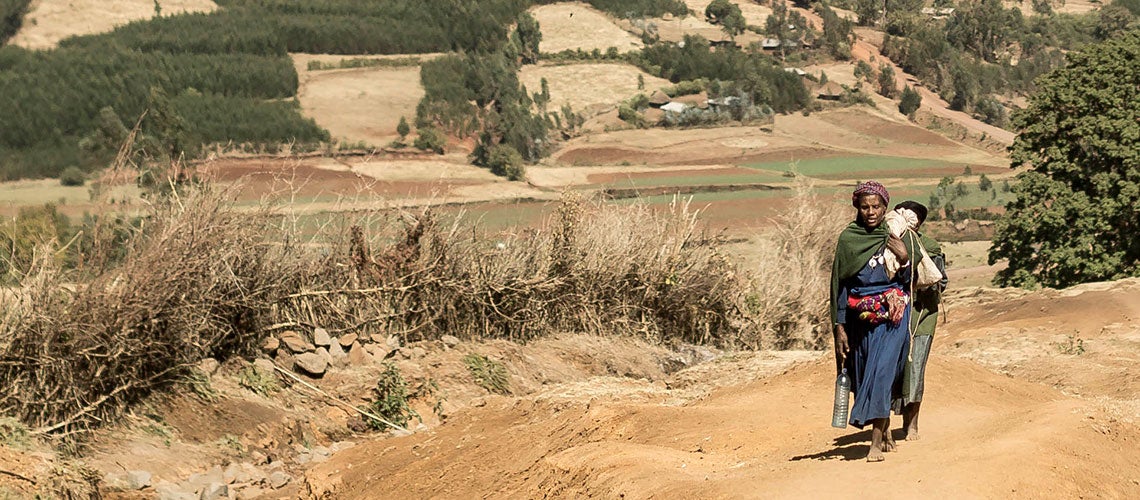 Ayjaseta Kebele in Fegeta Lakoma Woreda, Amhara Region, Ethiopia.
Ayjaseta Kebele in Fegeta Lakoma Woreda, Amhara Region, Ethiopia.
The public launch of a World Bank poverty assessment is usually a big event. Senior officials from government, ministers, and sometimes even presidents come together with researchers, development partners, and academics to discuss the latest poverty trends in a country and measures that could speed up poverty reduction. National press tends to be present and reports on the headline figures and messages in the country’s media.
But launching Ethiopia’s new poverty assessment may seem pro forma now, with the coronavirus (COVID-19) spreading through Africa and with severe health, economic, and social consequences expected to follow. However, although our new poverty assessment (short overview version here) focuses mainly on the 2011-2016 period, long before the pandemic started sweeping the world, its analysis can be used to assess the likely poverty impacts of the crisis and inform actions to alleviate them as effectively as possible.
Even as COVID-19 makes the picture more grim, there remain reasons for hope.
Households in urban areas will be affected first and perhaps most heavily by the virus and related containment measures. Though the growth elasticity of poverty—a measure of the extent to which gross domestic product growth translates into poverty reduction—has been low in Ethiopia as a whole, it has been high in urban areas, resulting in a drop in urban poverty from 26% in 2011 to 15% by 2016. This means that a significant slowdown in economic growth is likely to affect the pace of urban poverty reduction or even reverse it. In addition, poverty reduction in urban Ethiopia has been tightly linked to increasing returns to self-employment. And it is exactly this kind of employment (think about small shops, buna (coffee) stands, roadside cafeterias, shoe-shiners, casual laborers, etc.) that will be most heavily affected by life-saving social distancing measures. In light of this, poverty rates in urban areas may increase significantly.
Though rural areas may appear relatively unaffected by the immediate economic consequences of the virus, the disruption will be felt there as well. Poverty reduction in rural Ethiopia has been mainly driven by agricultural growth, especially in places that are well connected to urban markets. Anecdotal evidence suggests that these places are now the first to feel a slowing demand for food from urban areas, with vegetable prices decreasing considerably. If demand for food in urban areas drops significantly (linked to subdued activity in accommodation and food services as well as decreasing urban incomes), farmers’ incomes will suffer as well, especially for those who are more market-oriented.
Agricultural growth and, by extension, poverty reduction has been driven in part by increased use of modern inputs, such as improved seeds and chemical fertilizer. The procurement of these inputs is now at risk with global supply chains largely paralyzed due to the pandemic. If this situation persists, Ethiopian farmers will lack inputs for this year’s main planting season, potentially leading to food shortages and price spikes in early 2021, hurting both rural and urban areas.
While Ethiopia has made strong progress on poverty reduction, vulnerability remains high. Between 2012 and 2016, close to half of people in rural areas and small towns experienced at least one spell of poverty (meaning that they were below the poverty line at some point during this period). The high level of vulnerability means that a considerable share of households are at risk of falling into poverty in a severe income shock.
To illustrate, a shock across the country that reduces household consumption by 10 percent would, all else being equal, raise the poverty rate by 6 percentage points (from 23.5 to 29.5), eliminating all the gains made on poverty between 2011 and 2016. In urban areas a shock of this magnitude would raise poverty by a little more than 3.5 percentage points, pushing an estimated 800,000 people below the poverty line. In rural areas, where a higher proportion of the population is clustered just above the poverty line, the rise in the poverty level would be 6.6 percentage points (or 5.7 million people). A hypothetical income shock would hit the regions of Afar and Amhara particularly hard, given their high proportion of people just above the poverty line.
Figure 1: Simulated increase in poverty rates from a hypothetical 10% decrease in consumption

The poverty assessment documents large differences in schooling outcomes between urban and rural children and, to a lesser extent, between children in the bottom welfare quintile and those at the top. In 2016, more than 65% of youth aged 15-24 in urban Ethiopia had completed primary school (grade 8). In rural areas, the corresponding figure was only 21%. Children from low-income households in rural areas tend to drop out of primary school early, promoting the intergenerational transmission of poverty.
All schools have now closed across Ethiopia because of COVID-19. An important action in the short term will be to make sure that these temporary closures do not lead to permanent dropouts, in particular among these already vulnerable rural households. In the longer term, devising policies or interventions that keep children from poor rural families in school longer will be crucial in any attempt to share the benefits of growth more widely.
In the face of daunting challenges, what can be done to cushion the impact of the crisis on households’ living standards? Here too, the poverty assessment can offer some guidance. The Productive Safety Net Program (PSNP), Ethiopia’s flagship social protection program, covering about 8 million people in rural areas of the country, has significantly contributed to poverty reduction. If rural areas start to be heavily affected by the COVID-related income losses, the PSNP could scale up to cover more people and/or cover existing beneficiaries for a longer time. A similar approach can be adopted in urban areas, where the Urban Productive Safety Net Project (UPSNP) currently covers about 600,000 beneficiaries in 11 cities. The UPSNP could expand to provide temporary income support to heavily affected households in a larger number of cities.
Whatever the mechanism or instrument to respond to the crisis, one thing is crucial, in Ethiopia and all countries grappling with COVID-19: act fast and do whatever it takes.



Join the Conversation